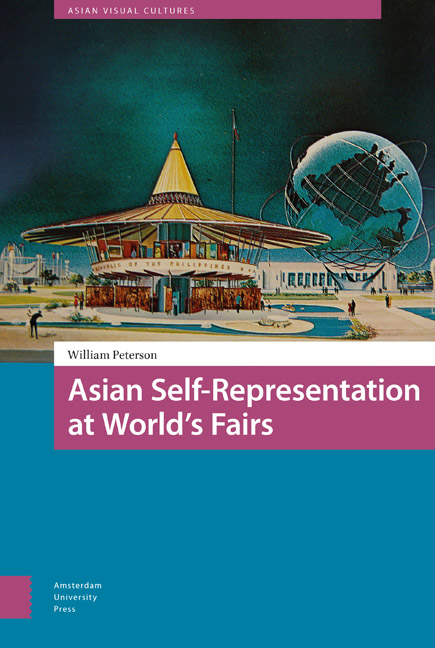Book contents
- Frontmatter
- Dedication
- Contents
- List of Figures
- Acknowledgements
- Note on Works Cited
- Note on Asian Names
- 1 Introduction: Setting the Stage
- 2 The Master of the Form: Japan at San Francisco's 1915 Panama-Pacific International Exposition
- 3 The New China and Chinese-Americanness: China at San Francisco's 1915 Panama-Pacific International Exposition
- 4 Performing Japan in the ‘World of Tomorrow’: Japan at the 1939-1940 New York World's Fair
- 5 From ‘Panda Diplomacy’ to Acrobat Diplomacy: China at the Brisbane's Expo ‘88
- 6 Fashion, Dance, and Representing the Filipina: The Philippines at the 1964-1965 New York World's Fair
- 7 Performing Modernity under Sukarno's ‘Roving Eye’: Indonesia at the 1964-1965 New York World's Fair
- 8 Maximizing Affect, Minimizing Impact with Hansik: South Korea at the 2015 Milan International Exposition
- 9 Hard and Soft Power in the Thai Pavilion: The Spectral Presence of King Bhumibol at the 2015 Milan Exposition
- 10 Conclusion: The Future of Asian Self-Representation at the International Exposition
- Works Cited
- Index
2 - The Master of the Form: Japan at San Francisco's 1915 Panama-Pacific International Exposition
Published online by Cambridge University Press: 21 November 2020
- Frontmatter
- Dedication
- Contents
- List of Figures
- Acknowledgements
- Note on Works Cited
- Note on Asian Names
- 1 Introduction: Setting the Stage
- 2 The Master of the Form: Japan at San Francisco's 1915 Panama-Pacific International Exposition
- 3 The New China and Chinese-Americanness: China at San Francisco's 1915 Panama-Pacific International Exposition
- 4 Performing Japan in the ‘World of Tomorrow’: Japan at the 1939-1940 New York World's Fair
- 5 From ‘Panda Diplomacy’ to Acrobat Diplomacy: China at the Brisbane's Expo ‘88
- 6 Fashion, Dance, and Representing the Filipina: The Philippines at the 1964-1965 New York World's Fair
- 7 Performing Modernity under Sukarno's ‘Roving Eye’: Indonesia at the 1964-1965 New York World's Fair
- 8 Maximizing Affect, Minimizing Impact with Hansik: South Korea at the 2015 Milan International Exposition
- 9 Hard and Soft Power in the Thai Pavilion: The Spectral Presence of King Bhumibol at the 2015 Milan Exposition
- 10 Conclusion: The Future of Asian Self-Representation at the International Exposition
- Works Cited
- Index
Summary
Abstract
By the early 20th century, Japan was the master of the international exhibition format. With over fifty years of experience at world's fairs in the West, Japan knew how to market its culture and products in a manner appealing to the Western consumer of both high art and decorative objects. The 1915 Panama Pacific International Exposition provided the country with a unique opportunity to create a strong and lasting imprint on American bodies in the country pavilion site with its famed gardens and exotic, kimono-clad women. As the epicenter of Asian migration, San Francisco also offered unique opportunities to further the power of Japonisme in the arts, while politicians in both countries used the event to champion Japanese-American relations.
Keywords: Japanese aesthetics, Japanese femininity, consuming Japan
As Europe was rushing headlong into war, the 1915 Panama Pacific International Exposition (PPIE) in San Francisco sought to embrace peace from the Pacific coast of an isolationist America. Despite the sinking of the passenger liner, the Lusitania, by German U-Boats with the loss of 128 American lives just a few months after the fair's opening, the American public and its political leaders were in no mood for war. The San Francisco exposition, which ran from 20 February to 4 December 1915, celebrated the completion of the Panama Canal, seen as the key to future economic prosperity through enhanced sea connections between the US and Asia as well as America's two coasts, with San Francisco, the financial centre and largest city on the American Pacific coast, taking a leading role. For San Franciscans, the fair was an opportunity to show off their glittering city, one that had been brought to its knees by the 1906 earthquake and ensuing fires that destroyed vast swathes of the ‘City by the Bay.’
The Japanese, like their American friends, viewed peace in the Pacific as a necessary counterbalance to the war enveloping Europe. At a diplomatic function in San Francisco immediately prior to the exposition opening, Admiral Baron Shigetō Dewa, one of Japan's most senior military commanders, enthusiastically proclaimed the PPIE a ‘Congress of International Peace,’ articulating the widely-held view that the canal would bring ‘increasing communication and intercourse among the peoples of the world,’ and provide ‘a real contribution to the cause of peace’ (San Francisco Chronicle, 4 Feb. 1915, p. 9).
- Type
- Chapter
- Information
- Asian Self-Representation at World's Fairs , pp. 39 - 78Publisher: Amsterdam University PressPrint publication year: 2020

